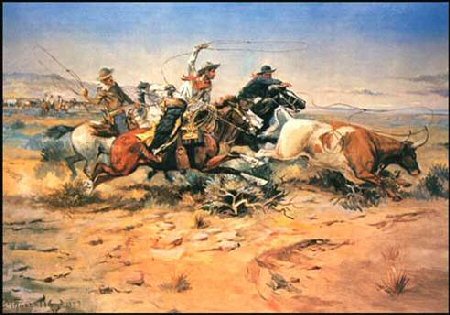
CHISHOLM TRAIL.

The Chisholm Trail was the major route out of Texas for livestock. Although it was used only from 1867 to 1884, the longhorn cattle driven north along it provided a steady source of income that helped the impoverished state recover from the Civil War. Youthful trail hands on mustangs gave a Texas flavor to the entire range cattle industry of the Great Plains and made the cowboy an enduring folk hero.
When the Civil War ended, the state's only potential assets were its countless longhorns, for which no market was available—Missouri and Kansas had closed their borders to Texas cattle in the 1850s because of the deadly Texas fever they carried. In the East was a growing demand for beef, and many men, among them Joseph G. McCoy of Illinois, sought ways of supplying it with Texas cattle. In the spring of 1867 he persuaded Kansas Pacific officials to lay a siding at the hamlet of Abilene, Kansas, on the edge of the quarantine area. He began building pens and loading facilities and sent word to Texas cowmen that a cattle market was available. That year he shipped 35,000 head; the number doubled each year until 1871, when 600,000 head glutted the market.
The first herd to follow the future Chisholm Trail to Abilene belonged to O. W. Wheeler and his partners, who in 1867 bought 2,400 steers in San Antonio. They planned to winter them on the plains, then trail them on to California. At the North Canadian River in Indian Territory they saw wagon tracks and followed them. The tracks were made by Scot-Cherokee Jesse Chisholm, who in 1864 began hauling trade goods to Indian camps about 220 miles south of his post near modern Wichita. At first the route was merely referred to as the Trail, the Kansas Trail, the Abilene Trail, or McCoy's Trail. Though it was originally applied only to the trail north of the Red River, Texas cowmen soon gave Chisholm's name to the entire trail from the Rio Grande to central Kansas. The earliest known references to the Chisholm Trail in print were in the Kansas Daily Commonwealth of May 27 and October 11, 1870. On April 28, 1874, the Denison, Texas, Daily News mentioned cattle going up "the famous Chisholm Trail."
The herds followed the old Shawnee Trail by way of San Antonio, Austin, and Waco, where the trails split. The Chisholm Trail continued on to Fort Worth, then passed east of Decatur to the crossing at Red River Station. From Fort Worth to Newton, Kansas, U.S. Highway 81 follows the Chisholm Trail. It was, Wayne Gard observed, like a tree—the roots were the feeder trails from South Texas, the trunk was the main route from San Antonio across Indian Territory, and the branches were extensions to various railheads in Kansas. Between 1871, when Abilene ceased to be a cattle market, and 1884 the trail might end at Ellsworth, Junction City, Newton, Wichita, or Caldwell. The Western Trail by way of Fort Griffin and Doan's Store ended at Dodge City.
The cattle did not follow a clearly defined trail except at river crossings;
when dozens of herds were moving north it was necessary to spread them out
to find grass. The animals were allowed to graze along for ten or twelve miles
a day and never pushed except to reach water; cattle that ate and drank their
fill were unlikely to stampede. When conditions were favorable longhorns actually
gained weight on the trail. After trailing techniques were perfected, a trail
boss, ten cowboys, a cook, and a horse wrangler could trail 2,500 cattle three
months for sixty to seventy-five cents a head. This was far cheaper than shipping
by rail.
The Chisholm Trail led to the new profession of trailing contractor. A few
large ranchers such as Capt. Richard King and Abel (Shanghai) Pierce delivered
their own stock, but trailing contractors handled the vast majority of herds.
Among them were John T. Lytle and his partners, who trailed about 600,000 head.
Others were George W. Slaughter and sons, Snyder Brothers, Blocker Brothers,
and Pryor Brothers. In 1884 Pryor Brothers contracted to deliver 45,000 head,
sending them in fifteen separate herds for a net profit of $20,000.
After the Plains tribes were subdued and the buffalo decimated, ranches sprang up all over the Plains; most were stocked with Texas longhorns and manned by Texas cowboys. Raising cattle on open range and free grass attracted investments from the East and abroad in partnerships such as that of Charles Goodnight and Irish financier John Adair or in ranching syndicates such as the Scottish Prairie Land and Cattle Company and the Matador Land and Cattle Company. Texas tried to outlaw alien land ownership but failed. The XIT Ranch arose when the Texas legislature granted the Capitol Syndicate of Chicago three million acres for building a new Capitol.
The Chisholm Trail was finally closed by barbed wire and an 1885 Kansas quarantine law; by 1884, its last year, it was open only as far as Caldwell, in southern Kansas. In its brief existence it had been followed by more than five million cattle and a million mustangs, the greatest migration of livestock in world history.
BIBLIOGRAPHY:
Wayne Gard, The Chisholm Trail; with Drawings by Nick Eggenhofer (Norman: University
of Oklahoma Press, 1954). Wayne Gard, "Retracing the Chisholm Trail," Southwestern
Historical Quarterly 60 (July 1956). Joseph G. McCoy, Historic Sketches of
the Cattle Trade of the West and Southwest (Kansas City, Missouri: Ramsey,
Millett, and Hudson, 1874; rpt., Philadelphia: Porcupine, 1974). Jimmy M. Skaggs,
The Cattle-Trailing Industry: Between Supply and Demand, 1866–1890 (Lawrence:
University Press of Kansas, 1973). Donald E. Worcester, The Chisholm Trail(Lincoln:
University of Nebraska Press, 1980).